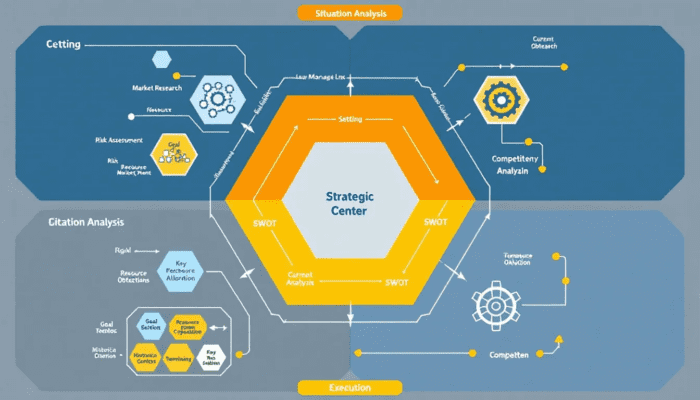How do business and military strategies compare? Both involve anticipating challenges, making critical decisions, and outperforming competitors. In this context, we can compare business and military strategies to explore their similarities and differences in strategic principles, objectives, and leadership.
Key Takeaways
- Both business and military strategies prioritize anticipating changes and informed decision-making, highlighting the importance of adaptability in competitive environments.
- The objectives of the two fields differ: military strategies focus on battlefield victories, while business strategies aim for market leadership. Yet both require comprehensive competitor analysis.
- Effective leadership and teamwork are essential in executing strategies, with good communication and clarity of vision being crucial for success in both business and military contexts.
The Essence of Strategy: Business vs. Military

Strategy is the art of making decisions under pressure, a common thread that ties together the worlds of business and the military. Business and military strategies involve anticipating moves, adapting to changing circumstances, and making calculated decisions to gain a competitive edge. Despite the apparent differences, strategic thinking and management's core principles remain strikingly similar.
A well-crafted business strategy can distinguish between market dominance and obsolescence, just as many military strategies often dictate the outcomes of critical battles. Integrating military and business strategies into business management offers a diverse and effective approach to meeting business objectives.
As we delve deeper into the specifics, you’ll see how these parallels affect various aspects of strategic planning and execution.
Defining Strategy in Business and Military Contexts
Strategy in both business and military contexts revolves around anticipating changes and making informed decisions. In business, it often involves foreseeing market trends and consumer behaviors, while in military contexts, it includes predicting enemy movements and responses. Both fields demand a deep understanding of the environment and swift adaptability to new information.
However, a key difference lies in competition. Military strategy is often a zero-sum game where one side’s gain is the other side’s loss. In contrast, the business world can sometimes foster cooperation for mutual benefit.
Military leaders concentrate on defeating enemies to fulfill their national strategies, while military strategists and business leaders strive to capture market share and outcompete rivals to drive growth and profitability. These distinctions shape the strategic approaches and objectives in each field.
Objectives and Goals
The objectives in business and military strategies are inherently different but share a common goal of dominance. Military objectives focus on securing battlefield victories and strategic assets, while business objectives aim for market leadership and increased market share. Business owners, much like military leaders, strive to outperform their competitors and establish a strong presence in their respective arenas.
Competitor analysis is vital in both contexts. As military leaders assess enemy positions and capabilities, businesses must comprehend their competitors’ strengths and weaknesses to apply strategic insights effectively. This understanding allows companies to position themselves advantageously against rivals, ensuring they achieve their business objectives and maintain a competitive edge.
Resources and Tactics
Efficient resource allocation underpins both business and military strategies. Businesses use budgeting and financial forecasting to maximize resources, while military operations focus on logistics and supply chain management to support troop deployment. Strategic resource use is critical to achieving desired outcomes in both domains.
Tactical maneuvers are also significant. This might involve strategic marketing campaigns or product launches to outmaneuver competitors. Military contexts entail coordinated attacks and defensive positions to gain the upper hand.
The synergy between resource allocation and tactical maneuvers allows organizations to respond effectively to competitive pressures and threats, ensuring a strategic advantage in their respective fields.
Knowledge as a Key Component

Knowledge is fundamental in both business and military strategies. It shapes strategic decision-making and enables organizations to adapt and thrive in dynamic environments. Curiosity and continuous learning foster a culture of innovation and adaptability, which is essential for success.
In business strategy, insights from classical texts like ‘The Art of War’ offer valuable lessons that can inform competitive approaches. Understanding the environment and analyzing competitors are crucial components of this knowledge framework, as we will explore further.
Understanding the Environment
Conducting an environmental scan helps identify external and internal factors impacting an organization’s success. This involves analyzing market trends, consumer behavior, and regulatory changes in the business environment. Recognizing and seizing market opportunities demands keen awareness of these changes, allowing businesses to stay ahead of the competition.
Effective planning includes identifying and mitigating risks through thorough market analysis. Understanding potential threats and opportunities allows businesses to allocate resources effectively and develop resilient strategies. This proactive approach resembles military logistics, where careful planning and resource allocation are critical to mission success.
Competitor Analysis
Competitor analysis is crucial in both business and military contexts. Knowing oneself and understanding the enemy, a principle emphasized in military strategy is equally important in business. Businesses significantly reduce their chances of success without a clear understanding of competitors.
Knowledge of competitors enhances strategic decision-making and allows organizations to anticipate and counter rival moves effectively. Utilizing networks and adhering to competition laws also play a crucial role in maintaining fair practices and avoiding unethical behavior.
Ethical guidelines ensure that competitive intelligence is gathered responsibly, maintaining the organization's integrity.
Leadership and Team Building
Leadership and team building are essential for successfully executing business and military leadership strategies. As Sun Tzu emphasized, understanding strengths and weaknesses is crucial for leaders to enhance their effectiveness.
In business, the owner often acts as the commander, guiding the organization toward its objectives with integrity and responsible decision-making. Effective leadership fosters a culture of continuous improvement and accountability, which is vital for achieving strategic goals.
Leadership Styles
Visionary leaders are essential in both business and military environments. They provide direction and motivation, aligning individual efforts with organizational goals. Leadership styles significantly influence the execution of strategies, with visionary leaders inspiring teams to work collaboratively towards common objectives.
Different leadership styles influence both tactical and strategic success. Adapting leadership approaches to specific situations is crucial for achieving desired outcomes. Effective leaders inspire, guide, and motivate their teams in business or military contexts to ensure successful strategy execution.
Building Effective Teams
Successful execution relies on clear vision communication and regular alignment meetings to foster teamwork. In business and military contexts, effective team communication enhances adaptability and fosters continuous improvement. Leaders must convey tough messages to ensure accountability among team members and align everyone with strategic goals.
Assigning the right people to roles enhances efficiency and supports the effective execution of business strategies. Diverse perspectives within teams contribute to better decision-making, and recognizing team members who embody core values strengthens team culture and commitment. Regular performance reviews and constructive feedback maintain high standards for team performance.
Planning and Flexibility

Planning and flexibility are critical for strategic success in both business and military contexts. Strategic frameworks emphasize planning, execution, and adaptability to overcome challenges. A well-crafted business plan guides navigating market complexities and uncertainties, while effective leadership transforms these plans into operational realities.
Considering unfavorable factors, as emphasized by military strategist Sun Tzu, is essential to avoid defeat.
Strategic Planning Processes
Avoiding errors should be an integral part of business strategy. A successful plan is characterized by simplicity, making it easier to implement. A structured business plan outlines clear objectives that align efforts across all stakeholders, ensuring everyone works towards common goals.
Achieving stakeholder buy-in is crucial to the success of the strategic planning process. Establishing measurable metrics is essential for assessing progress and ensuring the business remains on track.
Strategic partnerships enhance operational efficiency and provide shared resources during conflicts, supporting the successful execution of plans.
Adaptability and Agility
A culture of adaptability encourages innovation and enables organizations to capitalize on new opportunities. To succeed, businesses must remain flexible and responsive to rapidly changing environments. Plan flexibility allows businesses to respond swiftly to evolving market demands and challenges.
Successful strategies often involve continuous improvement and adaptation to changing circumstances. Contingency plans are crucial for team resilience in the face of unexpected challenges, ensuring organizations maintain their strategic advantage.
Networking and Alliances
Networking and forming alliances are critical for enhancing strategic positions in business and military scenarios. Alliances provide mutual support and access to essential resources, expertise, and collaborative opportunities that are pivotal for success.
Leveraging networks effectively allows businesses to gain the support they need to overcome challenges and achieve their objectives.
Strategic Partnerships
Leveraging networks allows businesses to gain essential support and resources pivotal for success. Strategic partnerships in business and military contexts significantly enhance the ability to achieve objectives and overcome challenges. These partnerships provide access to critical resources, expertise, and collaborative opportunities vital for gaining a competitive edge.
Forming strategic partnerships can help businesses navigate complex markets and achieve their objectives. By leveraging their partners' strengths, businesses can enhance their operational efficiency and create synergies that drive growth and success.
Leveraging Networks
Effective networking demands considerable time and energy to build and maintain connections. Actively managing contacts is crucial for establishing a robust networking foundation, enabling businesses to gather intelligence on competitors and market trends. Leveraging networks effectively can lead to acquiring essential information that enhances strategic decision-making and competitive advantage.
Businesses should leverage their strengths and established networks to maximize potential when seeking opportunities. Developing closer friendships within networks can enhance networking effectiveness, providing additional support and resources for strategic success.
Learning from Success and Failure

Engaging with successes and failures is vital for refining business and military strategies. Analyzing past successes and failures helps leaders fine-tune their strategic approaches, ensuring they learn from each experience to improve future outcomes.
This continuous learning and adaptation process is essential for maintaining a competitive edge and achieving long-term success.
Case Studies of Success
While the Battle of Borodino is a notable historical event, it serves as an example of strategies that led to minimal competitive advantage, illustrating the complexities of warfare. In the business world, companies like Android learned from the success of iOS, strategically timing their product launches to improve upon their predecessors' offerings. These instances highlight the importance of leveraging lessons from past successes to sustain competitive advantage and achieve business objectives.
To sustain a successful business strategy, continually leverage additional success from each new victory to ensure sustained competitive advantage. If businesses stop exerting effort after achieving success, they risk allowing the competition to seize emerging opportunities, leading to potential losses.
Lessons from Failures
Learning from failures is crucial in both business and military contexts. It informs future strategy and helps avoid repeating mistakes. The French army’s capture of Moscow became a burden, illustrating that strategic overreach can lead to failure. This example highlights the importance of understanding limits and avoiding overextension.
In business, failed operations often result from insufficient cross-functional communication and planning. Recognizing and addressing these weaknesses helps organizations refine their strategies and improve their chances of success in future endeavors, as a poorly executed strategy can lead to significant setbacks.
Leveraging past experiences allows leaders to accelerate their efforts for success and adapt based on previous outcomes.
Timing and Execution
Timing and flawless execution are critical for strategic success in both business and military contexts. Effective timing allows enterprises to take full advantage of opportunities, while flawless execution ensures that strategic plans are implemented effectively.
These elements are essential for transforming strategic visions into successful outcomes.
Importance of Timing
Timing allows businesses to seize opportunities when they are most advantageous. Sometimes, companies must wait for opportune moments and learn from competitors to maximize their impact. Effective timing can lead to significant advantages, such as entering markets when competition is minimal, ensuring a stronger foothold and better chances of success.
Waiting for the right moment and strategically launching initiatives can make a substantial difference in outcomes. By observing and learning from the timing of competitors’ moves, businesses can better plan their strategies and enhance their competitive position.
Execution Excellence
Comprehensive training is essential to ensure that team members can execute strategies effectively. In business and military contexts, well-trained teams are better equipped to handle unforeseen circumstances and adapt quickly to changes. This adaptability is crucial for maintaining a competitive advantage and achieving strategic goals.
Strategies should be adaptable to facilitate quick responses to unforeseen circumstances. Fostering a continuous improvement and adaptability culture ensures that execution remains aligned with strategic objectives, leading to long-term success.
Ethical Considerations
Ethical considerations are critical in both business and military strategies. Military ethics emphasize discipline and adherence to protocols, ensuring humane treatment of non-combatants and compliance with international law. Business ethics focuses on corporate responsibility, fair competition, and sustainable practices.
Both realms highlight the importance of ethical frameworks in fostering integrity and responsible decision-making.
Ethics in Business Strategy
Business ethics are principles that guide decision-making processes within organizations. Navigating ethical dilemmas often involves dealing with ambiguous situations where the right course of action isn’t clear. Leaders should promote transparency and invite feedback to enhance ethical behavior in their organizations.
Fulfilling ethical responsibilities can create long-term value for both the company and society. Unethical practices, such as false advertising, can damage a company’s credibility and result in significant financial losses. Employees are likelier to remain loyal to organizations that demonstrate commitment to ethical practices and corporate social responsibility.
Ethics in Military Strategy
Modern military missions face unique ethical challenges, particularly in asymmetric warfare, where adversaries may not adhere to conventional norms. Rules of engagement dictate the ethical use of force, ensuring military actions comply with international law and human rights. These principles are crucial for maintaining integrity and moral high ground in military operations.
Ethical considerations in military strategy often involve difficult decisions, such as balancing the need for decisive action with minimizing harm to civilians. The strategy involved treating soldiers adhering to established ethical guidelines, helping military leaders navigate these challenges, and maintaining the trust and support of their troops and the broader public.
Summary
In conclusion, the parallels between business and military strategies offer valuable insights for achieving success in both fields. From understanding the environment and analyzing competitors to effective leadership, planning, and ethical considerations, the principles of strategic thinking are universally applicable. Organizations can enhance their strategic advantages and achieve their objectives by learning from successes and failures and adapting to changing circumstances. Embrace these lessons, and let the art of strategy guide you to new heights of success.

Frequently Asked Questions - Compare Business and Military Strategy
What are the main similarities between business and military strategies?
Business and military strategies share key similarities, including competitive actions, decision-making under pressure, and the essential need for strategic planning and adaptability. Both require a proactive approach to anticipate changes and respond effectively.
How do business and military objectives differ?
Business and military objectives differ significantly; military objectives concentrate on achieving battlefield victories, whereas business objectives seek to attain market leadership and expand market share. This fundamental distinction highlights the divergent goals and strategies employed in each field.
Why is competitor analysis critical in both contexts?
Competitor analysis is crucial as it allows you to identify your rivals' strengths and weaknesses, facilitating informed strategic positioning. This insight enhances your competitive edge and informs your decision-making process.
What role does timing play in strategic success?
Timing is crucial for strategic success. It enables businesses to capitalize on opportunities effectively, influencing the overall success of their initiatives. Companies can maximize their impact and achieve better results by strategically aligning actions with the right moments.
How do ethics influence business and military strategies?
Ethics significantly shape business and military strategies by promoting responsible decision-making and ensuring compliance with established rules of engagement. This commitment to ethical standards enhances trust and accountability in both sectors.

Learn More About How to Compare Business and Military Strategy
Explore how the principles of military strategy can elevate your business game. Whether you want to strengthen competitive positioning, enhance operational efficiency, or foster a resilient organizational culture, we help you navigate your strategic journey.
Get Started Today:
- Schedule a Strategic Consultation: Discover tailored strategies for your business challenges. Book Now
- Explore More Insights: Dive deeper into strategic planning and execution. Read More
Don't miss out on leveraging proven tactics from military history to achieve business success. Transform your approach and lead with confidence.
Mark Hope
Partner, Asymmetric Marketing
📧 mark.hope@asymmetric.pro
📞 (608) 410-4450
About the author
Mark A. Hope is the co-founder and Partner at Asymmetric Marketing, an innovative agency dedicated to creating high-performance sales and marketing systems, campaigns, processes, and strategies tailored for small businesses. With extensive experience spanning various industries, Asymmetric Marketing excels in delivering customized solutions that drive growth and success. If you’re looking to implement the strategies discussed in this article or need expert guidance on enhancing your marketing efforts, Mark is here to help. Contact him at 608-410-4450 or via email at mark.hope@asymmetric.pro.


